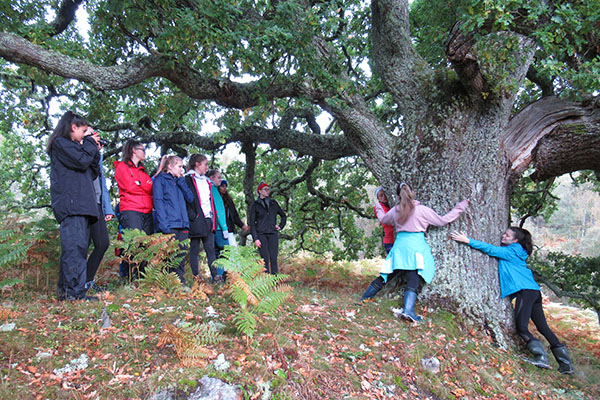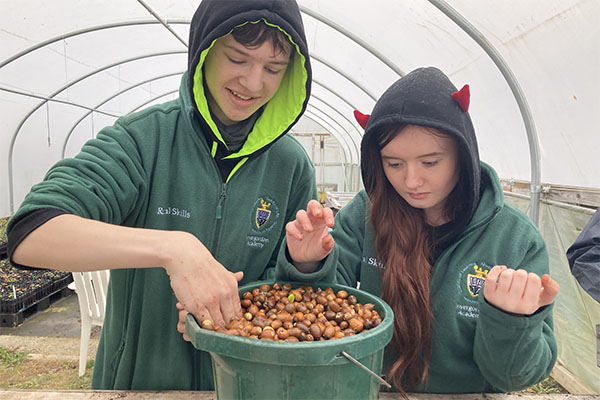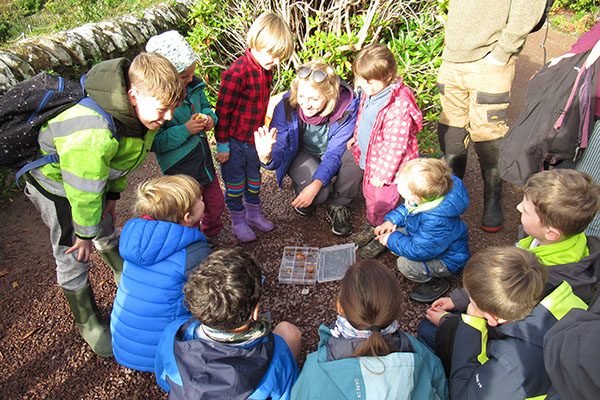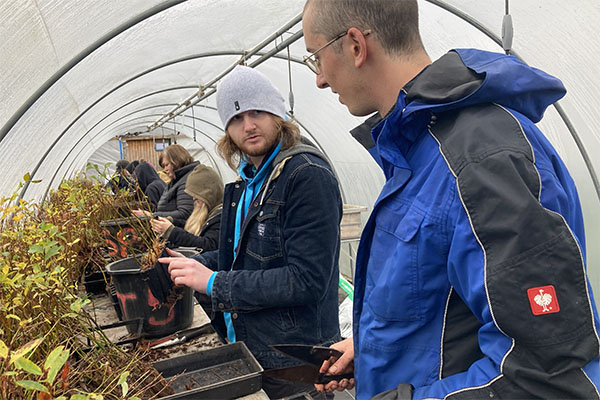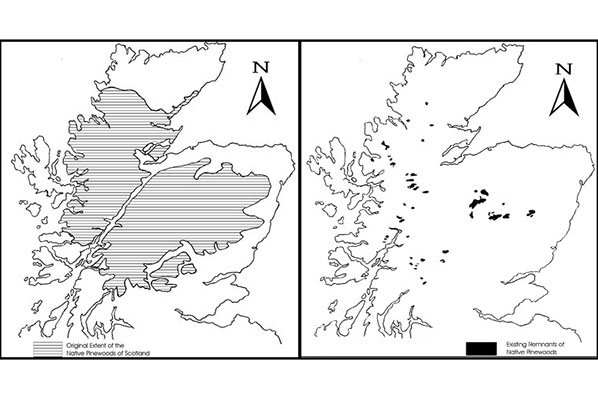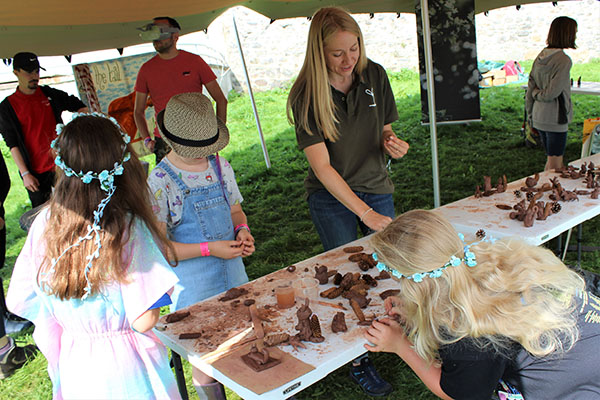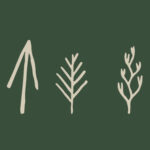Rewilding Q&A with young people from the Scottish Highlands
People are part of rewilding. And there is no group more important than local young people. Community engagement with schools is a key way to share ideas, knowledge, and stories about nature restoration and its possibilities. We recently held a virtual Q&A with the primary 7s from Avoch Primary school in the Black Isle. The pupils sent us some brilliant questions that we thought were too good not to share! If you’re interested in talking to your class, friends or family about rewilding – this Q&A might spark some good conversation. To arrange a virtual or in person visit for your school, you can get in touch with Kat – our Rewilding Centre Education Manager at kat@treesforlife.org.uk.
Kat is answering these questions alongside Alice, our Skills for Rewilding Digital Marketing trainee.
Q: What can we do at school, at home or in our community to help?
Alice: There are lots of ways you can get involved in rewilding! A great way to start is to learn more about your local environment. Find out about the different habitats near you, what kind of wildlife they support and talk to your friends and family about it. Sharing what you’ve learned helps spread the message of rewilding and could inspire others to think differently about the environment around them.
Kat: If you have a garden or some land you could carry out your own mini rewilding project. Planting wildflowers helps to support bees, butterflies and other pollinators. You could build a bug or a hedgehog hotel and let your grass grow long, to provide shelter for insects and small mammals.
Alice: You could also become a citizen scientist! This is public participation in scientific research, usually sharing information about your local environment. One example of this is reporting any squirrels you see to Saving Scotland’s Red Squirrels. You can report red and grey sightings, anywhere from your back garden to out in the woods. This helps us understand how far north grey squirrels have spread, as well as where red squirrels have returned to. Depending on where you live there could be other important monitoring you can help with. Find out which nature charities are working nearby and this could involve anything from hedgehogs, to rainfall, to moths, to river monitoring. There’s lots you can do in your local community!
Q: How do we help animals return?
Kat: I think the most important thing we can do is protect the habitats that we already have. When a forest disappears we don’t just lose trees, we lose a complex web of life including trees, plants, animals, fungi, microorganisms and more. Even if we replant trees, woodland takes a long time to mature and some things might be lost forever. Protecting what we have also means letting things change, evolve and spread over time. In some places we can give nature a helping hand by planting trees and reintroducing keystone species – things that are really important to an ecosystem and help to hold it together. For example, Scots pine is a keystone species which many insects, arachnids, fungi, birds and mammals depend on.
Alice: Another significant way we can support wildlife is by making connections between habitats so that animals can move around to find food and shelter. Joining up fragments of remaining woodland can have a really meaningful impact, allowing wildlife populations to grow and spread using these corridors.
Q: What animals are best to reintroduce?
Kat: That’s a really good question! The answer depends on lots of factors, and there might be different answers in different places. It’s important to get to know an area and find out what, or who, is already there. We have to think about how a reintroduced species will behave – what will it eat, where will it live, how will it move around the landscape, and of course we have to think about whether people and livelihoods will be affected. It’s important to make sure that any people who will be affected by a reintroduced animal get to have a say in decisions. Ultimately if local people are not supportive of a reintroduction then it is unlikely to be successful anyway. We need to share ideas and information and have a lot of conversations.
Q: What kind of trees do you plant?
Alice: Trees for Life was founded in 1989 and since then, with the help of lots of lovely volunteers, we have planted around 2 million trees! We grow and plant trees that are native to Scotland. This includes Scots pine, oak, birch, rowan, aspen, alder, willow, hazel, holly, juniper and cherry.
Kat: Our trees are all grown from local seeds, hand-collected by our nursery team and volunteers. This means we can grow trees which will do well in the Highlands, and helps to avoid the spread of tree diseases.
Q: Do you grow anything apart from trees?
Alice: We do! On the nursery we will sometimes grow other types of plant and at the moment we have a twinflower project. Twinflower is very distinctive with two pinkish-white bell shaped flowers growing on a forked stem. It is often described as being shaped like the letter Y. Twinflower likes to grow in old pinewood but this is a habitat we have lost a lot of in Scotland, so now this flower is quite rare.
Q: When woodland is restored will we see an increase in wildlife?
Kat: Absolutely! Restoring the Caledonian Forest will create habitat for a huge range of insects, arachnids, fungi, plants, birds, mammals and more. Rewilding is a slow process and this increase will happen gradually, but this year alone there have been lots of exciting developments at Dundreggan. Red squirrel sightings are becoming increasingly common, suggesting they are returning to pinewood on the estate. Many of us have come across feral boar this year as well, or seen evidence of them turning over the soil to look for food.
Alice: We also have golden eagles nesting on the estate! This summer a pair of barn owls roosted in one of the buildings at Dundreggan and managed to raise three chicks. They were likely attracted by the growing population of mice and voles that live in the long grass. This summer we also reconfirmed the presence of one of Scotland’s rarest bees, the small scabious mining bee! And through the autumn a few lucky people spotted white-tailed sea eagles, as they slowly reestablish themselves across Scotland.
Q: How many more trees need to be planted for us to recover all that have been lost?
Kat: It’s easier to think about the extent of the forest rather than a specific number of trees. These pictures show the original extent of Scotland’s native pinewood compared to the fragments we have left today. Such a vast amount of the Caledonian Forest has disappeared, and now the land is used for lots of different things. It’s hard to imagine recovering all that has been lost, but every bit of woodland we can restore helps provide habitat for wildlife as well as somewhere for people to explore and enjoy.
Alice: It’s important to plant where the forest or certain species of tree have completely disappeared but if there are mature trees in the area that can produce seed they will be able to spread out naturally. This is called natural regeneration and we want to support wild trees as much as possible! Rewilding is about creating space for nature to thrive and take care of itself.
The Skills for Rewilding traineeships have been made possible through funding provided by The National Lottery Heritage Fund as part of their “Skills for the Future” programme.

